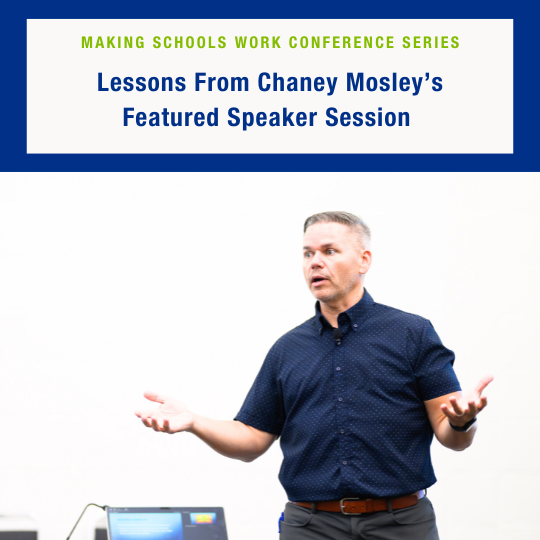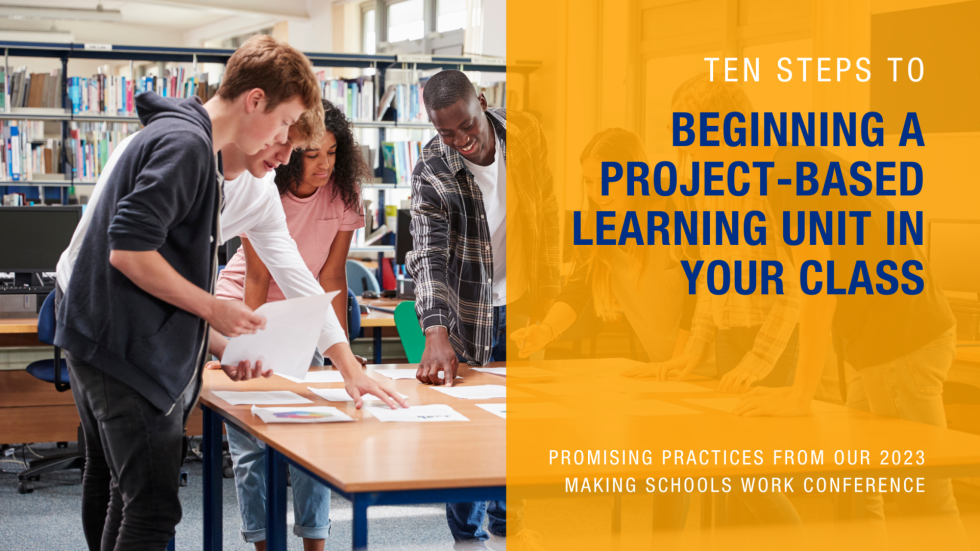Blog: Teaching and Coaching
Permission to Provoke: A 9 Step Guide to Teaching Controversial Topics With Confidence and Care
The 2025 Making Schools Work Conference was held in New Orleans from July 15-18. Over the next year, we will be giving you insights and lessons learned from many of the sessions we attended at the conference. In this post, we offer tips from Chaney Mosley on how to responsibly teach controversial topics.
Tips for Encouraging Safer, Smarter Technology Use in Your Schools
The 2025 Making Schools Work Conference was held in New Orleans from July 15-18. Over the next year, we will be giving you insights and lessons learned from many of the sessions we attended at the conference. In this post, we look at tips on creating safe technology use in schools from digital responsibility expert Katie Greer.
Life-Altering Lessons for Educators From the 2025 Making Schools Work Conference Keynote Address
The 2025 Making Schools Work Conference was held in New Orleans from July 15-18. Over the next year, we will be giving you insights and lessons learned from many of the sessions we attended at the conference. In this first post, we look at the motivational lessons we learned at Antonio Neve’s keynote address.
Project-ing Your Teaching: 10 Steps to Beginning a Project-Based Learning Unit in Your Class
Have you been wanting to try project-based learning in your classroom but have no idea where to start? This 10-step guide will tell you what you need to know to create your first PBL unit!
AI in Education Series Part 6: How to Pick an AI Tool for Your School
This is the final post in our series exploring the four pillars from Guidance for the Use of AI in the K12 Classroom. This time, we discuss the checklist that goes along with this report and examine ways that you can pick AI tools for your school.
AI in Education Series Part 5: Developing Ethical and Proficient AI Users
This is the fifth post in our series exploring the four pillars from Guidance for the Use of AI in the K12 Classroom. This time, we discuss ways that teachers can help students become ethical and efficient AU users of the future..
Believe : What Jason Adair (and Ted Lasso) Taught Us About Coaching
In the last post from our 2025 Coaching for Change Conference series, we look at lessons from Ted Lasso on what it means to be a good coach…whether that is instructional or sports.
AI in Education Series Part 4: How Teachers Can Use AI to Support Personalized Learning—Without Overcomplicating It
This is the fourth post in our series exploring the four pillars from Guidance for the Use of AI in the K12 Classroom. In this one, we talk about ways that AI can be useful in creating personalized learning plans for students.
Blowing the Whistle on Coaching: Maximizing Impact in Education
In the second-to-last post from our 2025 Coaching for Change Conference series, we look at why “blowing the whistle” every once in a while can be really good for an instructional coach to try.
AI in Education Series Part 3: How AI Can Lighten the Load for Teachers—Without Taking Over
This is the third post in our series exploring the four pillars from Guidance for the Use of AI in the K12 Classroom. In this post, we discuss ways that AI can be used to help teachers streamline their administrative and planning tasks.
Differentiated Coaching, Real Results: 7 Lessons for School Leaders That David Seale Taught Us About Supporting Every Teacher
In this post from our 2025 Coaching for Change Conference series, we look at lessons for school leaders in why creating differentiated coaching support for your team makes a huge difference in teacher retention and school culture.
What Stuck With Coaches: Top Takeaways From Day 1 of the 2025 Coaching for Change Conference
In the latest post in our 2025 Coaching for Change Conference series, we look at what attendees took away from Day 1 of the coaching conference.
A Practical Guide for Educators: How to Start Using AI in Your Classroom Today
In this first post in our five-part series on our new report, Guidance for the Use of AI in the K12 Classroom. We talk about what the report is, who it is for, and how you can get started using it today, no matter your current AI comfort level.
Vulnerability Is Not a Weakness: 5 Reasons Good Leaders (and Instructional Coaches) Aren’t Afraid of Being Vulnerable
In the third post in our Coaching for Change Conference insights blog series, we look at insights provided by Terri Seay Bryant on why being vulnerable is a great school leadership and instructional coaching trait.
Scooby-Dooby-Do You Know How to Maximize Your Coaching Support? 5 Mystery-Filled Tips From Kanisa Williams on How to IMPACT Your Teachers
In the second post in our Coaching for Change Conference insights blog series, Kanisa Williams from DeKalb County Schools in Georgia uses Scooby Doo to show you how instructional coaches can make a huge impact in their schools.
Slow Down to Speed Up: 7 Coaching Tips from Graham Fletcher
In this first post in our Coaching for Change Conference insights blog series, we look at seven lessons we got from Graham Fletcher’s opening address.
Georgia Teaching Residents Give Middle Grades STEM a Boost
Curtis Martin’s dedication to teaching is reflected in the quote from Victor Hugo displayed in Martin’s email signature: “He who opens a school door, closes a prison.”
You see, before Curtis became a Georgia math teacher, he was a correctional officer for the state of Georgia and the Houston County Sheriff’s Department. Having seen too many children end up behind bars, Martin decided to work with middle-grade students to give them opportunities that can improve their chances for success in life.
5 Lessons on School Leadership I Learned at the 2024 Making Schools Work Conference
What can you do as a school leader to make a difference for your teachers, staff and students? We look at five lessons in leadership we learned at the 2024 Making Schools Work Conference.
From Laughter to Learning: 6 Lessons From the Ron Clark Academy’s Michael Bonner
Wish you were still at the 2024 Making Schools Work Conference? We can’t provide a time machine, but we can help: Check out our coverage of the opening session in this post!
Generation Z Isn’t Interested in Teaching
Why Not?
As a graduate student in 2021, I interviewed Ms. Sharpe for an assignment in my Qualitative Research II course. Ms. Sharpe, a Black woman, member of Generation Z, and a fourth-grade teacher two years removed from her educator preparation program, expressed frustration, angst, worry, pride and hopelessness.























